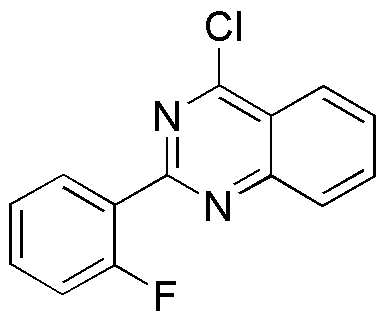4-Chloro-2-(2-fluorophenyl)quinazoline is widely utilized in research focused on:
- Pharmaceutical Development: This compound serves as a key intermediate in the synthesis of various pharmaceuticals, particularly in the development of targeted cancer therapies. Its unique structure allows for the design of potent inhibitors that can selectively target cancer cells.
- Biological Research: Researchers use this chemical to study its effects on specific biological pathways, aiding in the understanding of disease mechanisms and the development of new treatment strategies.
- Material Science: It finds applications in the creation of advanced materials, such as organic semiconductors and polymers, due to its electronic properties, which can enhance the performance of electronic devices.
- Diagnostic Tools: The compound is explored for use in diagnostic applications, particularly in imaging techniques that require specific binding to biological targets, improving the accuracy of disease detection.
- Environmental Chemistry: Its properties are investigated for potential applications in environmental remediation, where it can be used to develop methods for detecting and degrading pollutants in various ecosystems.
General Information
Properties
Safety and Regulations
Applications
4-Chloro-2-(2-fluorophenyl)quinazoline is widely utilized in research focused on:
- Pharmaceutical Development: This compound serves as a key intermediate in the synthesis of various pharmaceuticals, particularly in the development of targeted cancer therapies. Its unique structure allows for the design of potent inhibitors that can selectively target cancer cells.
- Biological Research: Researchers use this chemical to study its effects on specific biological pathways, aiding in the understanding of disease mechanisms and the development of new treatment strategies.
- Material Science: It finds applications in the creation of advanced materials, such as organic semiconductors and polymers, due to its electronic properties, which can enhance the performance of electronic devices.
- Diagnostic Tools: The compound is explored for use in diagnostic applications, particularly in imaging techniques that require specific binding to biological targets, improving the accuracy of disease detection.
- Environmental Chemistry: Its properties are investigated for potential applications in environmental remediation, where it can be used to develop methods for detecting and degrading pollutants in various ecosystems.
Documents
Safety Data Sheets (SDS)
The SDS provides comprehensive safety information on handling, storage, and disposal of the product.
Product Specification (PS)
The PS provides a comprehensive breakdown of the product’s properties, including chemical composition, physical state, purity, and storage requirements. It also details acceptable quality ranges and the product's intended applications.
Certificates of Analysis (COA)
Search for Certificates of Analysis (COA) by entering the products Lot Number. Lot and Batch Numbers can be found on a product’s label following the words ‘Lot’ or ‘Batch’.
*Catalog Number
*Lot Number
Certificates Of Origin (COO)
This COO confirms the country where the product was manufactured, and also details the materials and components used in it and whether it is derived from natural, synthetic, or other specific sources. This certificate may be required for customs, trade, and regulatory compliance.
*Catalog Number
*Lot Number
Safety Data Sheets (SDS)
The SDS provides comprehensive safety information on handling, storage, and disposal of the product.
DownloadProduct Specification (PS)
The PS provides a comprehensive breakdown of the product’s properties, including chemical composition, physical state, purity, and storage requirements. It also details acceptable quality ranges and the product's intended applications.
DownloadCertificates of Analysis (COA)
Search for Certificates of Analysis (COA) by entering the products Lot Number. Lot and Batch Numbers can be found on a product’s label following the words ‘Lot’ or ‘Batch’.
*Catalog Number
*Lot Number
Certificates Of Origin (COO)
This COO confirms the country where the product was manufactured, and also details the materials and components used in it and whether it is derived from natural, synthetic, or other specific sources. This certificate may be required for customs, trade, and regulatory compliance.


